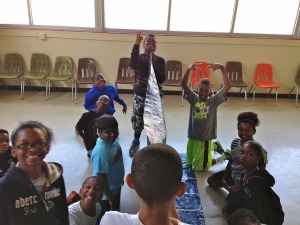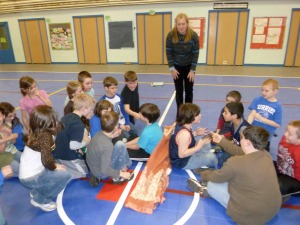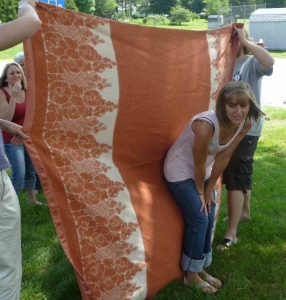Jun 15, 2015 Celebrations, Appreciating Others, and Positive Group Norms Activities
During this time of year, I find myself facilitating many staff team-building retreats for community organizations. In my work with schools, the focus is on celebrating the end of the year and goal setting for the next. For other programs, the goal is to develop the team or staff for upcoming summer programs. It is rewarding to help these programs build positive group norms and celebrate the contributions of individuals and the group. In this week’s post, I share an old favorite “Peek-a-Who” adapted to facilitate appreciations and celebrations and build positive group norms.
“Peek-A-Who” Appreciations/Celebrations Variation
 Materials: blanket, sheet or tarp
Materials: blanket, sheet or tarp
Purpose: celebrations/appreciations of others, use of descriptive language (adjectives), listening, recognizing the strengths of others, healthy trust, respect, and reflection, celebrating the community and positive group norms
Facilitation Suggestions:
• In this variation of the “Peek A Who” name game (see my fall 2012 post) one participant from each team is chosen to sit (or stand) with his or her back to the tarp/blanket.(Two facilitators or group members hold the tarp/blanket vertically between them so that they do not know how is on the other side of the tarp).
• When the blanket dropped on the count of three, the back-to-back pair remain with their backs to each other while their teammates describe the person from the other team, using only positive non-physical descriptors(i.e. “He is very creative,” “She is good at math,” “She climbed Mt. Washington last week,” “He was the leader of the last group challenge”).
• I encourage the group to think about what this person has contributed to the group and use examples of when this person’s strengths benefited the group – making this a reflective activity as well as a celebration
 •The back-to-back pair tries to guess who is behind them based on this information.
•The back-to-back pair tries to guess who is behind them based on this information.
• This activity is an opportunity to have a discussion about what descriptive language is and the difference between physical characteristics and personal strengths or qualities
• Sometimes in their excitement the group gets too loud for the guessers to hear their descriptions. During one program, a 6th grader suggested that each guesser pick three people they will hear descriptors from, and it worked well. Before each term, the describers were chosen by the guesser (making sure everyone gets a chance to be a describer).
 Variations: Use this as a reflection activity by asking the group members to describe the other person by his or her positive contributions to a specific group project or challenge.
Variations: Use this as a reflection activity by asking the group members to describe the other person by his or her positive contributions to a specific group project or challenge.
Facilitation Notes:
Most of the time there are many memorable, positive comments; though it takes practice for some groups to stop using physical descriptors. This appreciations version of the game is a great opportunity for participants to celebrate the strengths and positive qualities of their peers and hear some nice things about themselves.
Outcomes/Reflection:
This activity can also be a vehicle for practicing and discussing positive group norms. When something negative is said during this activity (with proper sequencing it should be a rare occurrence), you know it it could be happening in other situations with the group, so this is a great opportunity to address it and initiate a conversation on group norms.
Reference: This write up is an excerpt from the Inspired Educator, Inspired Learner book. The name variation of this activity is a New Games Foundation favorite and was coined “Peek-a-Who in Quicksilver by Karl Rohnke and Steve Butler. The appreciations version comes from Tips & Tools for the Art of Experiential Group Facilitation by Jennifer Stanchfield, Wood ‘N’ Barnes Publishing 2007.



No Comments